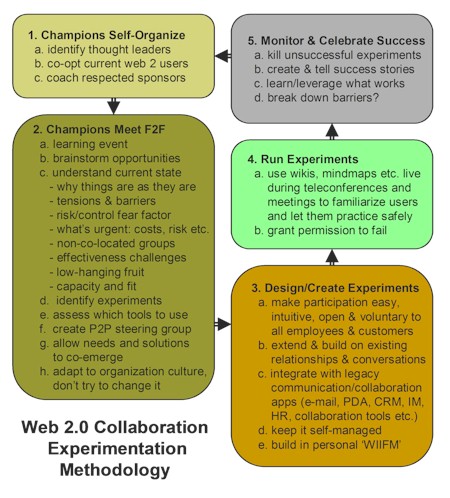Planning vs Co-Evolution in Knowledge Management
It’s my day for thanking Clive for some interesting links. This post from Dave Pollard summarised in his diagram (below) looks like a really good way to get started with using Web 2.0 technologies to improve collaboration in the enterprise. His suggestion is to let a strategy emerge: start with some simple ideas and easy-to-do experiments, resource the ones that work, and drop the ones that don’t (the best of all strategies in a complex, shifting domain).
In Dave’s words: “You have to let a full understanding of the organization’s problems and needs, and the solutions that address those needs, co-evolve.”
I sometimes wish that organisations would be more open to such co-evolution approaches in broader KM strategy buiding as well. Too often, we find people prefer a more defined planning approach that gives them a great sense of security and direction for the longer term. They want to do a “one shot” strategy that defines a complete programme of activity five years into the future, for example. But when we build that with them, they often find it’s intimidating and very complicated to handle, because we’re trying to cover too many bases and uncertainties looking that far into the future. Big plans often do not survive the hurly burly of change, especially changes in organisation leadership or KM programme teams.
The chaps over at Anecdote have been thinking about facilitating knowledge strategy processes, and have built a nice list of typical KM interventions and objectives, which they use as attractors for leadership teams to figure out what’s most important to them. This lighter touch approach might be more adaptive and fluid in line with the co-evolution approach proposed by Dave Pollard, so long as management attention can be sustained over time, and leadership teams are willing to revisit their KM journey on a regular, more than perfunctory basis.
That’s not always easy for KM teams in the organisations we encounter to buy into. An organisation may be naturally averse to such fluid, experimental approaches. It may even be structured against them in the way that budgets are allocated and planned. They want to commit funds for activity in a defined period let’s say, and procurement guidelines, especially in government, require them to define deliverables up to completion. Leadership just wants to get a comprehensive strategy in place, set up the system to implement it, hand it over to the KM team and set it rolling, while they move their attention elsewhere.
That’s often not a good thing, but it is a fact of life. It’s hard to know where the balance between planning and co-evolution needs to be for any given organisation, but it’s probably a factor of the speed of change in an organisation, the stability of its leadership and its KM teams, and the level of experience and confidence in the KM team. More experience probably means greater capacity to plan. Less experience probably means a greater need to learn and take small steps – to co-evolve the sense of purpose with the solutions adopted.
One thing I do know for sure: sustained attention from leadership is critical – and if the planned approach has any false promise, it is that it might encourage leadership to think that they can take their eye off the KM ball. It’s not just about getting management attention. It’s about keeping it.
1 Comment so far
Page 1 of 1 pages
Comment Guidelines: Basic XHTML is allowed (<strong>, <em>, <a>) Line breaks and paragraphs are automatically generated. URLs are automatically converted into links.


I mentioned the Anecdote list of KM intiatives as attractors for management discussion in my post above. I used a similar list last week as part of an early discussion with a client, and ran into one of the dangers of lists: the client said “Of course, I want them all!”
Posted on May 22, 2007 at 10:34 AM | Comment permalink